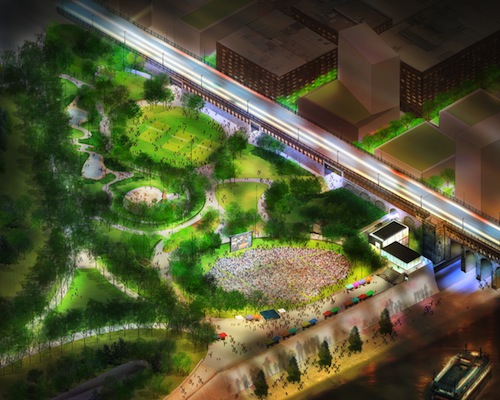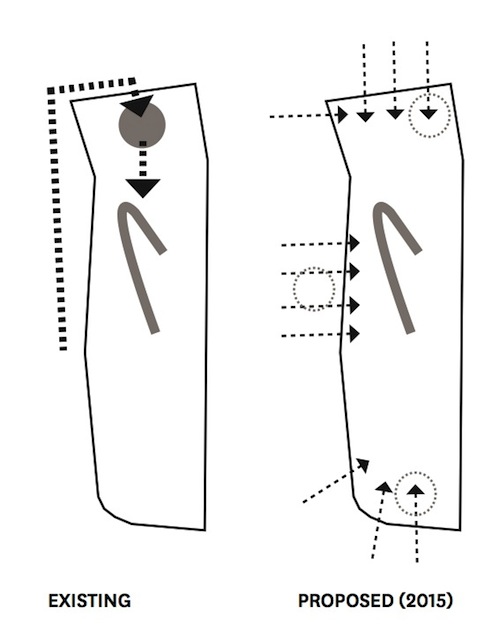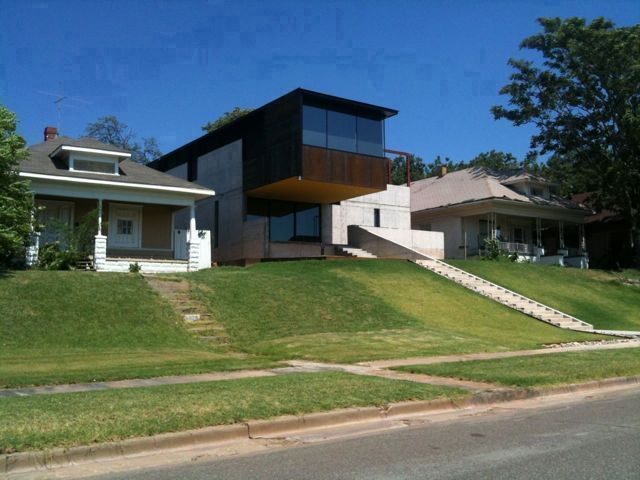The following is a press release from this afternoon:
Sept. 21, 2010
MVVA Team Moves Forward in City+Arch+River 2015 Competition
“Strong Team and Solid Methodology” Pushes Team Led by Michael Van Valkenburgh into 90-day Program Analysis and Design Development Effort
ST. LOUIS–(BUSINESS WIRE)– Landscape architect Michael Van Valkenburgh and a multidisciplinary team introduced as experts in “urban renewal, preservation, commemoration, social connections and ecological restoration” have been picked for the planning phase of The City+The Arch+The River 2015 International Design Competition.
Leaders of the team will be introduced, along with details on the next stages of the process, at 10:00 a.m., Friday, Sept. 24, 2010, at the Old Courthouse in downtown St. Louis.
The jury chose the MVVA Team over four others competing to enliven the area around the Gateway Arch and connect it to downtown St. Louis, the Mississippi River and the Illinois bank. Based in New York, MVVA’s portfolio includes the redesign of Pennsylvania Avenue at the White House, the design of Brooklyn Bridge Park and many other prominent projects. (Please see the MVVA Team profile at end of this document for information on expertise and accomplishments of its members.)
In its final report, the competition jury called the MVVA Team “a strong team with solid methodology.” As a team, “they convey intelligence and provide clear technical support for their design proposals,” the jury report states.
“MVVA is an outstanding team that presented a winning combination of the ambitious and the manageable,” said Tom Bradley, Superintendent of the Jefferson National Expansion Memorial. “They showed great reverence for the beauty and significance of the existing site, while suggesting improvements and attractions in line with our competition goals. We’re excited to start planning.”
Over a 90-day period, the team will work in partnership with the sponsors, the City of St. Louis, the National Park Service and others to further define program requirements; begin developing a design that takes into account the feasibility and practicality of proposed solutions; create a construction budget and fundraising plan; and define the delivery expectations from now until 2015.
“Between now and January, we will be challenging the MVVA Team to rise to the challenge to do what’s best for the city, for the region and for this national park,” said St. Louis Mayor Francis Slay. “The Arch is a national treasure, but it is intensely personal to people in and around St Louis. We will be working with Michael and his team, with continued input from the community and the experts, on creating the best solutions for the Arch grounds and the neighboring area.”
“There is huge potential for the Illinois riverbank area and collaboration on both sides of the river,” said Dr. Vaughn Vandegrift, Chancellor of Southern Illinois University at Edwardsville, who serves with Bradley, Mayor Slay and others on the competitions governing group. “Our discussions regarding Illinois intensified and evolved even after the competition was launched. There are opportunities for the Illinois riverbank area now that didn’t exist when we gave instructions to the teams. We will work closely with the MVVA Team to evaluate what they have proposed and expand from there.”
Strong support for project implementation was shared last month in a letter to competition organizers from the bi-partisan Missouri and Illinois congressional delegations and during a visit by the U.S. Secretary of the Interior, Ken Salazar, who oversees the National Park Service and pledged to get the project done.
“This is another critical step in a continuum that began with the review of the park’s general management plan and continued on to the call for a competition, the skillful execution of the competition itself, today’s announcement of a winning design team, the establishment of an implementation team and a concept from which we can build,” said Bradley. “We are looking to this effort as a model for both public-private collaboration and improved connections between cities and our urban national parks.”
The MVVA Team’s design concept narrative describes their vision for the redesigned park as a “centerpiece of civic culture, an engine of regional economic growth, a showcase for sustainable ecological restoration and a celebration of the national significance of this historic place.”
The sponsoring group, the MVVA Team and others will host intensive reviews and workshops this fall to analyze the design concept and conduct a more detailed design exploration. At a minimum, the study will focus on the review of the technical advisory group, the impact on related downtown park properties and the Illinois side of the river, traffic and transportation and federal compliance issues.
The sponsors also will study issues relating to cost and construction, traffic, financial resources and federal compliance.
A monthly web-based progress report will update the public throughout the implementation period.
The eight-member jury counted among its members a Pulitzer Prize-winning architecture critic, a professor in the humanities, a former deputy director of the National Park Service, a real estate economist, a museum curator and renowned architects and landscape architects.
The jury shared its report and team rankings with the competition sponsor and managers after a series of presentations and tours of the community, competition site and exhibit of design concepts led by the sponsors and culminating in public presentations by the teams late last month.
The project will be constructed by Oct. 28, 2015, the 50th anniversary of the completion of the Arch.
About the Competition
The goal of The City+The Arch+The River 2015 international design competition is to create an iconic setting for the international icon, the Gateway Arch, honoring its immediate surroundings and weaving connections and transitions from the city and the Arch grounds to the Mississippi River, including the east bank in Illinois.
The competition, launched Dec. 8, 2009, has had three stages. Portfolio submissions in Stage I included a description of the lead designer, a statement of design intent and philosophy of the lead designer, a profile of the design team and examples of their work. From the original 49 submissions, in February 2010, the jury picked nine to enter Stage II.
Stage II involved the formation of the complete teams capable of executing the project, submission of required qualifications and a jury interview. This phase culminated in early April 2010, when the teams met with the jury and the field was narrowed to five teams.
On April 28, 2010, at the beginning of Stage III, the finalist teams presented their design philosophies and examples of past work at a public “Meet the Design Teams” event in downtown St. Louis, hosted by sportscaster Joe Buck. This event was followed by a three month design concept competition to explore the finalists’ design approach and test their working methodology.
The design concepts went on display on Aug. 17, 2010, at the Arch and in an exhibit traveling throughout the bi-state region. Visitors were able to voice opinions about the design concepts in the first week of the exhibit. A synopsis of the more than 600 comments received was shared with the jury. The finalist teams presented their design concepts to the jury in public session on Aug. 26, 2010.
The final project design, budget and implementation plan will be presented in January 2011. The project will be constructed by Oct. 28, 2015.
The new design is called for in the National Park Service’s General Management Plan for the Jefferson National Expansion Memorial, which was developed with extensive public input over an 18-month period and approved Nov. 23, 2009.
The competition is sponsored by the CityArchRiver 2015 Foundation, which includes National Park Superintendent Tom Bradley, St. Louis Mayor Francis G. Slay, community leaders from Missouri and Illinois, academics, architects and national park advocates.
Financial contributions to the CityArchRiver 2015 Foundation are being handled by the Greater St. Louis Community Foundation, a public charity with more than $140 million in charitable assets and representing more than 350 individual funds.
Donors to the competition include: Emerson, Gateway Center of Metropolitan St. Louis (Malcolm W. Martin Memorial Park), Peter Fischer, Emily Rauh Pulitzer, Civic Progress, Wachovia Wells Fargo Foundation, Danforth Foundation, John F. McDonnell, Bryan Cave LLP, Greater St. Louis Community Foundation, National Park Foundation, Monsanto, Alison and John Ferring, Bank of America, David C. Farrell and others who choose to remain anonymous. The traveling exhibit was sponsored by Civic Progress member companies.
Competition information at www.cityarchrivercompetition.org.
###
The MVVA Team
LANDSCAPE URBANISM
Since 1982, Michael Van Valkenburgh Associates has completed over 350 landscape architecture and urban planning projects. MVVA has emerged as a leader in sustainable landscape design, with a particular interest in urban ecology, stormwater management, materials salvage, and soil remediation. Over the last decade, MVVA has designed several highly acclaimed, infrastructurally complex waterfront landscapes, including Brooklyn Bridge Park and Hudson River Park in New York, Allegheny Riverfront Park in Pittsburgh, and the Lower Don Lands in Toronto. In addition, MVVA has successfully rehabilitated many historic landscapes, including the Harvard University campus, Pennsylvania Avenue at the White House, and Dan Kiley’s Miller Garden in Columbus, Indiana. MVVA is one of the most consistently lauded firms in practice today; in addition to its many project awards-which include two 2010 Designing the Parks awards from the National Park Service-Michael Van Valkenburgh has been regularly commended for his contributions to the field. He won the Cooper-Hewitt Design Museum’s 2003 National Design Award for Environmental Design, and this year he became only the second landscape architect to be awarded the American Academy of Arts and Letters’ Arnold W. Brunner Memorial Prize in Architecture-Dan Kiley is the other.
URBAN DESIGN, DEVELOPMENT, AND PROGRAMMING
Ken Greenberg is a leading expert on the life and design of the post-industrial North American city. His work includes the Lower Don Lands in Toronto, the Anacostia Waterfront in Washington, D.C., the Rose Kennedy Greenway in Boston, and master plans for Philadelphia and Detroit; he was given the 2010 Thomas Jefferson Award for Public Architecture. Ed Uhlir masterminded the design and programming of Chicago’s Millennium Park, which has attracted $2.6 billion in tourism and has had a $1.4 billion impact on nearby property values. John Alschuler of HR&A Advisors has pioneered innovative phasing and financing schemes for large-scale urban projects including the High Line and Brooklyn Bridge Park in New York. Cooper, Robertson & Partners has designed programming for world-class institutions including the Metropolitan Museum of Art, the Museum of Modern Art, and the Whitney Museum.
ARCHITECTURE
James Carpenter Design Associates has integrated art and architecture, with a particular focus on light and glass, in projects including 7 World Trade Center in New York and the Lens Ceiling in Phoenix, Arizona; James Carpenter was a 2004 MacArthur “genius” fellow. Steven Holl is one of the United States’ most eminent living architects; his record of built work includes the award-winning addition to the Nelson-Atkins Museum of Art in Kansas City, which consists of five “lenses” seamlessly integrated into a Dan Kiley landscape. Structural engineer Guy Nordenson has collaborated with Steven Holl and MVVA for many years, and has worked with Renzo Piano, Pei Cobb Freed, and many other leading architects.
ECOLOGICAL, HYDROLOGICAL, AND CIVIL ENGINEERING
Arup is a leading international engineering firm with a broad range of specialties; their work includes Hudson River Park and the East River Waterfront in New York, as well as the Sydney Opera House and work for the 2008 Beijing Olympics. Hydrological science and engineering firm LimnoTech has expertise in surface water modeling, contaminant analysis, wastewater and stormwater collection systems, and riverine and wetland hydrodynamics. Applied Ecological Services is a broad-based ecological consulting firm consisting of a multidisciplinary team of botanists, biologists, and ecosystem restoration specialists; its work includes environmental permitting efforts, natural resources inventories, and prairie and wetland restoration projects. ABNA Engineering provides local civil engineering support.
ART, LANDSCAPE HISTORY, AND PUBLIC OUTREACH
Throughout her career, Ann Hamilton has integrated multi-sensory public art installations into existing and newly built architecture and landscape projects; she was a 1993 MacArthur “genius” fellow. Elizabeth K. Meyer is a professor at the University of Virginia and one of the foremost American landscape theorists. In addition to her influential work on Dan Kiley, she has written about the complexities inherent in building new landscapes on industrial sites, and has argued for incorporating aesthetic concerns into the sustainability agenda. Award-winning design firm Project Projects specializes not only in identity and graphic design, but also wayfinding and public outreach efforts. They are supported locally by Vector Communications.





